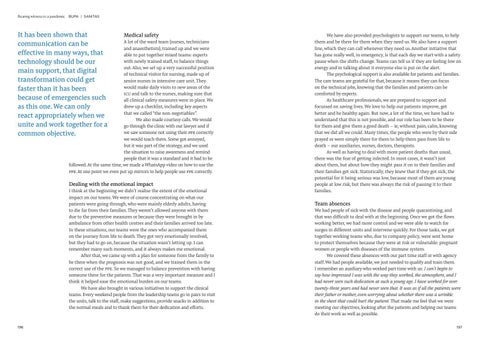Bearing witness to a pandemic BUPA | SANITAS
It has been shown that communication can be effective in many ways, that technology should be our main support, that digital transformation could get faster than it has been because of emergencies such as this one. We can only react appropriately when we unite and work together for a common objective.
Medical safety
A lot of the ward team (nurses, technicians and anaesthetists), trained up and we were able to put together mixed teams: experts with newly trained staff, to balance things out. Also, we set up a very successful position of technical visitor for nursing, made up of senior nurses in intensive care unit. They would make daily visits to new areas of the icu and talk to the nurses, making sure that all clinical safety measures were in place. We drew up a checklist, including key aspects that we called “the non-negotiables”. We also made courtesy calls. We would go through the clinic with our lawyer and if we saw someone not using their ppe correctly we would teach them. Some got annoyed, but it was part of the strategy, and we used the situation to raise awareness and remind people that it was a standard and it had to be followed. At the same time, we made a WhatsApp video on how to use the ppe. At one point we even put up mirrors to help people use ppe correctly.
Dealing with the emotional impact
I think at the beginning we didn’t realise the extent of the emotional impact on our teams. We were of course concentrating on what our patients were going through, who were mainly elderly adults, having to die far from their families. They weren’t allowed anyone with them due to the preventive measures or because they were brought in by ambulance from other health centres and their families arrived too late. In these situations, our teams were the ones who accompanied them on the journey from life to death. They got very emotionally involved, but they had to go on, because the situation wasn’t letting up. I can remember many such moments, and it always makes me emotional. After that, we came up with a plan for someone from the family to be there when the prognosis was not good, and we trained them in the correct use of the ppe. So we managed to balance prevention with having someone there for the patients. That was a very important measure and I think it helped ease the emotional burden on our teams. We have also brought in various initiatives to support the clinical teams. Every weekend people from the leadership teams go in pairs to visit the units, talk to the staff, make suggestions, provide snacks in addition to the normal meals and to thank them for their dedication and efforts.
196
We have also provided psychologists to support our teams, to help them and be there for them when they need us. We also have a support line, which they can call whenever they need us. Another initiative that has gone really well, in emergency, is that each day we start with a safety pause when the shifts change. Teams can tell us if they are feeling low on energy and in talking about it everyone else is put on the alert. The psychological support is also available for patients and families. The care teams are grateful for that, because it means they can focus on the technical jobs, knowing that the families and patients can be comforted by experts. As healthcare professionals, we are prepared to support and focussed on saving lives. We love to help our patients improve, get better and be healthy again. But now, a lot of the time, we have had to understand that this is not possible, and our role has been to be there for them and give them a good death - ie, without pain, calm, knowing that we did all we could. Many times, the people who were by their side prayed or were simply there for them to help them pass from life to death - our auxiliaries, nurses, doctors, therapists. As well as having to deal with more patient deaths than usual, there was the fear of getting infected. In most cases, it wasn’t just about them, but about how they might pass it on to their families and their families get sick. Statistically, they knew that if they got sick, the potential for it being serious was low, because most of them are young people at low risk, but there was always the risk of passing it to their families.
Team absences
We had people of sick with the disease and people quarantining, and that was difficult to deal with at the beginning. Once we got the flows working better, we had more control and we were able to watch for surges in different units and intervene quickly. For those tasks, we got together working teams who, due to company policy, were sent home to protect themselves because they were at risk or vulnerable: pregnant women or people with diseases of the immune system. We covered these absences with our part time staff or with agency staff. We had people available, we just needed to qualify and train them. I remember an auxiliary who worked part time with us: I can’t begin to say how impressed I was with the way they worked, the atmosphere, and I had never seen such dedication at such a young age. I have worked for over twenty-three years and had never seen that. It was as if all the patients were their father or mother, even worrying about whether there was a wrinkle in the sheet that could hurt the patient. That made me feel that we were meeting our objectives, looking after the patients and helping our teams do their work as well as possible. 197































